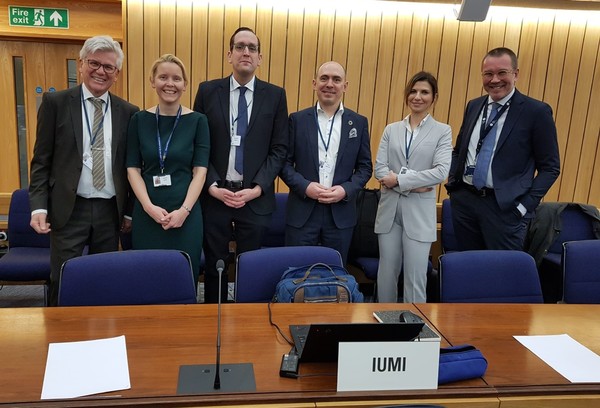The Sub-Committee on Ship Systems and Equipment (SSE) deals with technical and operational matters related to systems and equipment on all types of ships and mobile units. This includes life-saving equipment as well as fire detection and fire extinguishing systems.
The tenth session of the SSE Sub-Committee was held from 4-8 March 2024 at the IMO and was chaired by Umut Şentürk from Türkiye. IUMI was represented by the Secretariat as well as several Technical Committee members to participate in the Fire Protection Working Group (FPWG).
Containership fire safety
The Sub-Committee has been tasked to develop amendments to SOLAS chapter II-2 and the FSS Code concerning detection and control of fires in cargo holds and on the cargo deck of containerships. This issue has been advanced to the IMO’s agenda with strong input from IUMI.
The Cargosafe study served as a basis for the Committee’s and FPWG’s discussion which includes several proposed risk control options. In addition to the Cargosafe study several other proposals were submitted to the Sub-Committee which looked at fixed water monitors, video fire detection, and the need for performance standards for water mist lances.
IUMI had submitted a joint proposal with France and BIMCO in which certain RCOs from the Cargosafe study were emphasized as particularly relevant to achieve significant improvements for fire protection and detection onboard containerships. During the WG discussions IUMI advocated especially for heat detection looking at individual container temperature rises and on-deck container stack cooling and containment systems such as fixed water monitors. Making portable infrared thermal imagers a mandatory requirement was further supported by IUMI, not only for newbuilds but also for the existing fleet, since it is a cost-efficient means to enable the crew to locate a fire.
Risk prevention related issues were also discussed in the FPWG. Initial measures such as container screening and improved stowage requirements were considered. These and other options will be forwarded to the Sub-Committee on the Carriage of Cargoes and Containers (CCC) which will discuss these further.
The discussions at SSE 10 served as an initial outline of key issues which should be looked at in more detail by an SSE Correspondence Group and the CCC Sub-Committee. SSE 10 hence established a Fire Protection Correspondence Group which will look at the following issues:
- Portable infrared (IR) thermal imagers.
- Draft guidelines for the design, performance, testing and approval of water mist lances.
- Feasibility of the means for extended reach for breaching tools to be used in conjunction with water mist lances.
- Improvements for existing mobile water monitors.
- Systems suitable for large deck cargo arrangements such as fixed water monitors.
- Review of fixed CO2 fire extinguishing systems.
IUMI intends to participate in the Correspondence Group to provide input from the insurers’ perspective.
At the next SSE session, video fire detection systems, protection of hatch covers, implications for other systems, e.g. water pump capacity, will be discussed further.
New energy vehicles
MSC 105 had agreed to include in its agenda an item titled "Evaluation of adequacy of fire protection, detection and extinction arrangements in vehicle, special category and ro-ro spaces in order to reduce the fire risk of ships carrying new energy vehicles". The item should be considered by the SSE Sub-Committee and completed in four sessions, i.e. starting in 2024 and concluding in 2027. The applicability of the new measures for existing ships as well as the charging of electric vehicles on board should further be addressed by the Sub-Committee.
The plenary discussed whether different hazards emanate from different types of vehicles. It was further debated whether fixed firefighting systems can ensure fires from new energy vehicles such as EVs can be successfully fought. Emergency response procedures, crew training and equipment aspects needed to be given priority, particularly for the existing fleet.
The FPWG discussed items for fire protection, detection, and extinction arrangements to reduce the fire risk of ships carrying new energy vehicles, including battery electric vehicles (BEVs). It was noted that the conditions are different for ro-ro passenger ships, ro-ro cargo ships and vehicle carriers.
The following roadmap was agreed by the WG:
- review of scientific reports and studies, new technologies, casualty reports and other available credible resources;
- identification of hazards related to new energy vehicles, including BEVs, compared to conventional internal combustion engine vehicles (ICEVs);
- consideration of a goal-based approach;
- identification of gaps in existing regulations and consideration of the way forward to mitigate the gaps; and
- identification of placeholders for possible future amendments (i.e. SOLAS regulation II-2/20 for all ro-ro ships or regulation II-2/20-2 for a given segment).
The Group further agreed on a goal-based approach which was outlined in more detail. This included the actual goal of decreasing and minimizing the risk of fire in vehicle spaces; the hazard identification, i.e. the identification of hazard and risk of fire of new energy vehicles; an examination of existing regulations to cover hazards identified; and potential functional requirements, e.g. fire detection capability to detect a vehicle fire and identify vehicle(s) on fire; fire control capability by cooling the ship structures and vehicles (vehicles on fire and surrounding vehicles); and fire containment capability in the vehicle spaces (possibly by fire-rating boundaries or active fire boundaries or fire curtains).
This topic will also be discussed further in a Correspondence Group in which IUMI plans to participate.
